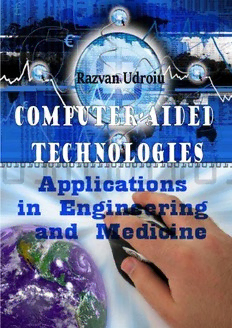
Computer-aided Technologies: Applications in Engineering and Medicine PDF
Preview Computer-aided Technologies: Applications in Engineering and Medicine
Computer-aided Technologies Applications in Engineering and Medicine Edited by Razvan Udroiu Computer-aided Technologies: Applications in Engineering and Medicine Edited by Razvan Udroiu Published by ExLi4EvA Copyright © 2016 All chapters are Open Access distributed under the Creative Commons Attribution 3.0 license, which allows users to download, copy and build upon published articles even for commercial purposes, as long as the author and publisher are properly credited, which ensures maximum dissemination and a wider impact of our publications. After this work has been published, authors have the right to republish it, in whole or part, in any publication of which they are the author, and to make other personal use of the work. Any republication, referencing or personal use of the work must explicitly identify the original source. As for readers, this license allows users to download, copy and build upon published chapters even for commercial purposes, as long as the author and publisher are properly credited, which ensures maximum dissemination and a wider impact of our publications. Notice Statements and opinions expressed in the chapters are these of the individual contributors and not necessarily those of the editors or publisher. No responsibility is accepted for the accuracy of information contained in the published chapters. The publisher assumes no responsibility for any damage or injury to persons or property arising out of the use of any materials, instructions, methods or ideas contained in the book. Publishing Process Manager Technical Editor AvE4EvA MuViMix Records Cover Designer ISBN-10: 953-51-2788-8 ISBN-13: 978-953-51-2788-8 Print ISBN-10: 953-51-2787-X ISBN-13: 978-953-51-2787-1 C ontents Preface Chapter 1 Introductory Chapter: Integration of Computer-Aided Technologies in Product Lifecycle Management (PLM) and Human Lifecycle Management (HUM) by Razvan Udroiu Chapter 2 Computer‐Aided Manufacturing of Working Units for High‐ Performance Mining Machines by Piotr Cheluszka Chapter 3 Joining in Nonrigid Variation Simulation by Kristina Wärmefjord, Rikard Söderberg, Björn Lindau, Lars Lindkvist and Samuel Lorin Chapter 4 Computer-Aided Techniques for Geometry Assurance by Andrea Corrado and Wilma Polini Chapter 5 Computer-Aided Clinical Decision Support Systems for Atrial Fibrillation by Prasanth Ganesan, Mark Sterling, Steven Ladavich and Behnaz Ghoraani Chapter 6 Computer-Aided Biosensor Design by Yu-Chen Lo, Ren Gui, Hiroshi Honda and Jorge Z. Torres Chapter 7 Computer-Aided Diagnosis in Neuroimaging by Francisco J. Martínez-Murcia, Juan Manuel Górriz and Javier Ramírez Preface The aim of this book is to present the latest applications, trends, and developments of computer-aided technologies (CAx). Computer- aided technologies are the core of product lifecycle management (PLM) and human lifecycle management (HUM). This book has seven chapters, organized in two sections: "Computer- Aided Technologies in Engineering" and "Computer-Aided Technologies in Medicine." The first section treats the different aspects of PLM, including design, simulations and analysis, manufacturing, production planning, and quality assurance. In the second part of the book are presented CAx applications in medicine focused on clinical decision, diagnosis, and biosensor design. CAx plays a key role in a variety of engineering and medical applications, bringing a lot of benefits in product life cycle, extending and improving human life. Chapter 1 Provisional chapter Introductory Chapter: Integration of Computer-Aided Introductory Chapter: Integration of Computer-Aided Technologies in Product Lifecycle Management (PLM) Technologies in Product Lifecycle Management (PLM) aanndd HHuummaann LLiiffeeccyyccllee MMaannaaggeemmeenntt ((HHUUMM)) RRaazzvvaann UUddrrooiiuu AAddddiittiioonnaall iinnffoorrmmaattiioonn iiss aavvaaiillaabbllee aatt tthhee eenndd ooff tthhee cchhaapptteerr http://dx.doi.org/10.5772/66202 1. Introduction The major objectives of computer-aided technology (CAx) are to simplify and to improve human's work (engineer, architect, physician, surgeon, etc.), by using the computer as an indispensable tool to solve a problem in a certain field (engineering and production, medicine, architecture, business, teaching, economy, etc.) [1]. The advanced computer-aided technologies (CAx) are focused on solving specific problems by increasing human’s creativity and innovation obtained through collecting, using, and sharing information between interdisciplinary teams. Computer-aided technologies in X field are general terms to define a technology, from a specific field of work, which is computed-aided. The substitute for X includes engineering (CAx-E), medicine (CAx-M), natural science (CAx-S), education (CAx-Ed), etc. Nowadays, computer-aided technologies are not islands of automation, being integrated in general context of Lifecycle Management in X field. The concepts used to define the lifecycle management in engineering and medical field are the following (see Figure 1): • Product lifecycle management (PLM) in the industry field • Human lifecycle management (HUM) or health management across the human lifecycle 4 Computer-aided Technologies - Applications in Engineering and Medicine Figure 1. Schematic representation of lifecycle management in industry, medicine, and natural science. 2. Computer-aided technologies in product lifecycle management Product lifecycle management (PLM) is the process of managing the entire lifecycle of a product including conception, design, manufacturing, quality control, use, service, and disposal of products, having integrated people, data, methods, CAx tools, processes, and business systems [2, 3]. PLM is a digital paradigm, products being managed with digital computer, digital information, and digital communication [3]. The main benefits of product lifecycle management (PLM) for the industry field are faster time- to-market, improved productivity, better product quality, decreased cost of new product introduction, improved design review, and approval processes, identifying potential sales opportunities and revenue contributions and reducing environmental impacts at end-of-life.
